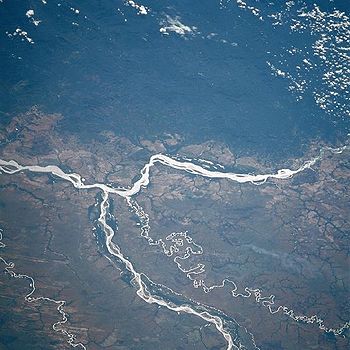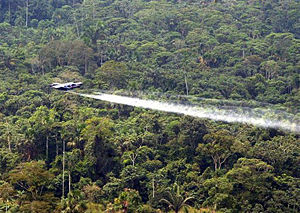
Deforestation in Colombia
Encyclopedia

Colombia
Colombia, officially the Republic of Colombia , is a unitary constitutional republic comprising thirty-two departments. The country is located in northwestern South America, bordered to the east by Venezuela and Brazil; to the south by Ecuador and Peru; to the north by the Caribbean Sea; to the...
loses 2,000 km2 of forest annually to deforestation
Deforestation
Deforestation is the removal of a forest or stand of trees where the land is thereafter converted to a nonforest use. Examples of deforestation include conversion of forestland to farms, ranches, or urban use....
, according to the United Nations
United Nations
The United Nations is an international organization whose stated aims are facilitating cooperation in international law, international security, economic development, social progress, human rights, and achievement of world peace...
in 2003, although some suggest that this figure is as high as 3,000 km² due to illegal logging
Illegal logging
Illegal logging is the harvest, transportation, purchase or sale of timber in violation of laws. The harvesting procedure itself may be illegal, including using corrupt means to gain access to forests; extraction without permission or from a protected area; the cutting of protected species; or the...
in the region.
Deforestation results mainly from logging for timber, small-scale agricultural ranching, mining, development of energy resources such as hydro-electricity, infrastructure, cocaine
Cocaine
Cocaine is a crystalline tropane alkaloid that is obtained from the leaves of the coca plant. The name comes from "coca" in addition to the alkaloid suffix -ine, forming cocaine. It is a stimulant of the central nervous system, an appetite suppressant, and a topical anesthetic...
production, and farming. Around one-third of the country's original forest has been removed as a result of deforestation.
Deforestation in Colombia is mainly targeted at primary rainforest which covers more than 80% of the country. This has a profound ecological impact in that the country is extremely rich in biodiversity
Biodiversity
Biodiversity is the degree of variation of life forms within a given ecosystem, biome, or an entire planet. Biodiversity is a measure of the health of ecosystems. Biodiversity is in part a function of climate. In terrestrial habitats, tropical regions are typically rich whereas polar regions...
with 10% of the world's species, making it the second most biologically diverse country on Earth.
Causes and effects
One of the main causes of deforestation in Colombia is the national Plan Pacifico which is intended to raise revenue to develop the economy. The plan includes exploitation of the country's rainforests for the extraction of precious natural resources for exportation.
Virgilio Barco Vargas
Virgilio Barco Vargas was a politician and diplomat from Colombia. He was a member of the Colombian Liberal Party and served as president of Colombia from August 7, 1986 until August 7, 1990....
(1986-1990), a development scheme was initiated involving $4.5 billion in investments to develop the Colombian Pacific Coast in Choco Department. Around 2.2% of the total forest area in Colombia began to be removed each year for wood and to make paper or to provide the clearings needed for palm plantations and agricultural production and commercial shrimp farming. In a concerted effort to enhance trade, Plan Pacifico has attempted to complete the 54 kilometer missing section of the Pan-American Highway
Pan-American Highway
The Pan-American Highway is a network of roads measuring about in total length. Except for an rainforest break, called the Darién Gap, the road links the mainland nations of the Americas in a connected highway system. According to Guinness World Records, the Pan-American Highway is the world's...
between Colombia
Colombia
Colombia, officially the Republic of Colombia , is a unitary constitutional republic comprising thirty-two departments. The country is located in northwestern South America, bordered to the east by Venezuela and Brazil; to the south by Ecuador and Peru; to the north by the Caribbean Sea; to the...
and Panama
Panama
Panama , officially the Republic of Panama , is the southernmost country of Central America. Situated on the isthmus connecting North and South America, it is bordered by Costa Rica to the northwest, Colombia to the southeast, the Caribbean Sea to the north and the Pacific Ocean to the south. The...
spanning the ecologically rich Darien Gap
Darién Gap
The Darién Gap is a large swath of undeveloped swampland and forest separating Panama's Darién Province in Central America from Colombia in South America. It measures just over long and about wide. Roadbuilding through this area is expensive, and the environmental toll is steep. Political...
. The construction of the Puente Terrestre Inter-Oceanico (PTI), the land bridge between the Pacific and Atlantic Oceans near Panama, consisting of a railway, road, canal, and oil pipeline has had a major impact on the environment and forest removal in the region. Other plans for road construction throughout Chocó which intended to catapult economic production in Colombia have had unintended negative consequences.
The economic potential of the region has resulted in international competition for access to the Colombian market with transnational corporations taking an active role in Colombia's deforestation through petroleum and mineral extraction in coordination with the national plan.
The Japanese government has directly financed the construction of a road which links the Pacific coast to inland forest regions to facilitate trade.
Deforestation has been responsible for the erosion of riverbanks which have affected the levels of river beds, which has had negative impacts on aquatic life and fish stocks as well as on transportation and navigation because of silting.

Palm oil
Palm oil, coconut oil and palm kernel oil are edible plant oils derived from the fruits of palm trees. Palm oil is extracted from the pulp of the fruit of the oil palm Elaeis guineensis; palm kernel oil is derived from the kernel of the oil palm and coconut oil is derived from the kernel of the...
and sugar cane production by encouraging large scale plantations, and demand for agrofuels has also had a significant impact on Colombia's forests, biodiversity, and local communities. Exploitation of communities through palm oil expansion has often resulted in violence and abuse of human rights
Human rights in Colombia
According to the U.S. Department of State 2003 human rights report for Colombia, Colombia’s human rights record, despite significant improvements by police and military forces in some areas, remained poor.-Security forces:...
. NGOs working in Colombia have recorded 113 deaths as a result of land-based conflicts over palm oil production in Curvaradó and Jiguamiandó River Basin in the Chocó region, where paramilitaries associated with plantation companies have been accused of exploiting lands collectively held by Afro-Colombian communities. The coastal lowland forests of Chocó province that are most affected by palm oil production are amongst the most biodiverse forests on Earth, home to 7,000 to 8,000 species, with over 2,000 endemic plant species and 100 endemic bird species.
The biologically rich forests of Colombia's Pacific Coast have also been affected by gold mining
Gold mining
Gold mining is the removal of gold from the ground. There are several techniques and processes by which gold may be extracted from the earth.-History:...
and cocoa production. One figure obtained in the mid-1990s estimated that gold mining activities were responsible for the clearance of 800 square kilometres of forest per year in Colombia, in addition to increased siltation in rivers and mercury
Mercury (element)
Mercury is a chemical element with the symbol Hg and atomic number 80. It is also known as quicksilver or hydrargyrum...
contamination.
The cultivation, production, and distribution of illegal narcotics in Colombia has also had a profound impact on deforestation and loss of biodiversity in the country. An estimated 100000 acres (404.7 km²) are allocated each year to grow coca, marijuana, and opium
Opium
Opium is the dried latex obtained from the opium poppy . Opium contains up to 12% morphine, an alkaloid, which is frequently processed chemically to produce heroin for the illegal drug trade. The latex also includes codeine and non-narcotic alkaloids such as papaverine, thebaine and noscapine...
poppies resulting in the direct removal of primary forest to provide for the trade. Particularly affected are the forests of the Colombian Andes
Andes
The Andes is the world's longest continental mountain range. It is a continual range of highlands along the western coast of South America. This range is about long, about to wide , and of an average height of about .Along its length, the Andes is split into several ranges, which are separated...
where at least 73% of this precious ecosystem has been affected by drug cultivation and migration of people for illegal resource extraction. The area is of prime importance for Colombia's water supply, and a disruption of soils and the water table arising from the removal of forest cover is of major concern to the climatic patterns of the country.

Response
Colombia has made great strides in protecting vast areas of land from deforestation through the creation of national parks; however, enforcement is by no means completely effective. The sale of protected land though government corruption is not uncommon. One notorious example is the attempted government conversion of the Tayrona forest on Colombia's Atlantic Coast into a national park in 1980. When the Tayrona National Natural ParkTayrona National Natural Park
The Tayrona National Natural Park is a protected area in the Colombian northern Caribbean region and within the jurisdiction of the Department of Magdalena and some 34 km from the city of Santa Marta...
was established, 90% of the land was under government control, but by 1990, 80% of the park had been expropriated through illegal logging and selling of land illegally by corrupt administrators.

